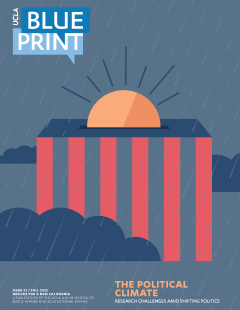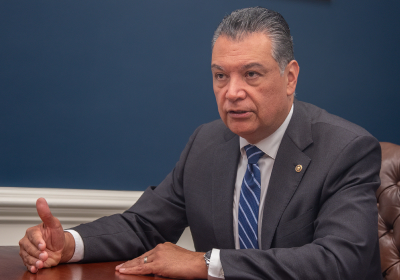On Jan. 20, 2025, Donald Trump did two things for the second time: He took the presidential oath. And he signed an executive order pulling the United States out of the Paris Climate Accords.
Los Angeles at the time was reeling over the still-smoldering wildfires in Pacific Palisades and Malibu, another in Altadena, and a series of smaller fires that together killed at least 31 people and destroyed close to 20,000 homes and other structures.
Economists with the UCLA Anderson Forecast estimated capital costs alone at between $76 billion and $131 billion. They calculated additional billions in lost GDP and wages. It has become one of the most costly disasters in American history.
The vast majority of climate scientists concur that the tinder-dry conditions and the hurricane-force winds that made the fires so disastrous were exacerbated by more than a century of industrial and domestic carbon emissions that have caused the planet to heat and weather patterns to shift from historical norms. In other words, by climate change.
Touring the scene a few days after his inauguration, President Trump brushed aside the role of greenhouse gases and instead repeated two false talking points: California burned because it failed to either “rake the forests” or to turn a mythical valve that supposedly would have carried water from Canada or the Columbia River to Los Angeles.
There is no such water pipeline, nor has there ever been. As for raking the forests, it barely deserves examination, since it’s unreasonable and nonsensical. But just to be clear: California has some 33 million acres of forested land — about the size of New York State. Even in a make-believe land where forests are raked, that’s a lot of raking.
Trump v. California
Welcome to Trump versus California, Environment Edition, Part 2. At stake are nothing less than the place of science and fact in public policy; federalism (the power relationship between the states and the federal government); and, by the way, the survival of humanity and the fate of the planet. With all of that on the line, researchers are determined to keep up their work, not so much as a frontal challenge to Trump or his presidency as to gird for and respond to the reality of a warming planet. The climate takes no heed of elections.
During the first Trump administration, California fought the president’s attempted environmental rollbacks by going to court and by reaching out to the world. In the Spring 2018 Blueprint, Ann Carlson, the Shirley Shapiro Professor of Environmental Law and co-director of UCLA’s Emmett Institute on Climate Change and the Environment, noted that then-Gov. Jerry Brown met with world leaders in China to broker a climate change agreement. Trump may have pulled the U.S. out of the Paris Accords, but Brown made it clear that California was still very much in the climate fight.
Brown “played a really important leadership role in showing just how powerful subnational jurisdictions can be,” Carlson said at the time.
Brown’s successor, Gov. Gavin Newsom, also has gone to China to negotiate climate agreements and has committed California to achieve net-zero carbon emissions by 2045 by slashing oil consumption.
But it’s complicated. Even as he has worked to reduce emissions, Newsom has backed away from plans to cut in-state oil production and is trying to keep refineries open in California to hold down gasoline prices — and perhaps to preserve his presidential prospects.
That’s not the only part of the political dynamic that’s different this time. Trump now has Congress in his corner and, on many issues, a majority on the Supreme Court.
“Last time,” Carlson noted, “the state negotiated an agreement with five car companies” to control emissions, in effect allowing California, one of the world’s largest economies, to set a nationwide standard that is more restrictive than federal standards.
It could do that because for more than a half-century it was granted a succession of waivers from the rules that otherwise preempt state action on air pollution in favor of national standards set by the Environmental Protection Agency.
But Congress has power to override EPA regulations, and in May it acted for the first time to nullify California’s waivers. The state’s ban on in-state sales of most emission-spewing cars by 2035 and its programs to limit truck exhaust have been suspended.
Threats to progress
Separately, California is at risk of losing its federal tax credits for solar and wind energy production as well as a host of other projects and regulations that have made the state the nation’s leader in combating climate change.
“Now,” Carlson said, “California’s leverage has been undercut. The state doesn’t have any recourse but to fight it out in court.”
Meanwhile, the EPA is moving to scrap its 2009 determination that carbon dioxide, not previously deemed a pollutant, endangers human health by contributing to global warming. A Supreme Court ruling two years earlier made the EPA “endangerment finding” possible, but the court’s composition has since changed — with three Trump appointees — and the ruling might not survive reconsideration.
Mary Nichols, Distinguished Counsel for UCLA’s Emmett Institute on Climate Change and the Environment, chaired the California Air Resources Board under Gov. Arnold Schwarzenegger and then for Brown’s final two terms.
She said she sees little likelihood of compromise between the California approach to climate change and the Trump worldview. But that’s not the end of the story.
“Right now we’re at a strangely interesting or complicated inflection point,” Nichols said. “There is little if any respect for the accomplishments of state and local governments in the environmental policy arena. Yet you’ve got a Supreme Court that is trying to give states more independence from the federal government.”
If the court modifies or overturns Massachusetts v. Environmental Protection Agency — the 2007 ruling that permitted the EPA to regulate greenhouse gas emissions — Carlson posits that states would be free to adopt their own standards because there would be no federal carbon standard to preempt.
“It’s a plausible argument,” she said.
Or if the court does not overturn the ruling, a future EPA could reinstate the endangerment finding.
And if the Clean Air Act is deemed not to apply to greenhouse gases, Carlson said, federal common law might kick in, allowing lawsuits over the “nuisance” of power plant and vehicle emissions.
None of these speculative scenarios are preferred options for people who acknowledge that climate change is an imminent threat to the planet. But at least there may be options.
In a sense, UCLA is a major headquarters for the fight against climate change. In addition to the Emmett Institute at the School of Law, the university’s research arsenal includes the Institute of the Environment and Sustainability, the Luskin School of Public Affairs, the Anderson School of Management, the Fielding School of Public Health, and academic disciplines that study the impact of carbon emissions and climate change on plants, animals, the oceans and cities, as well as directly on human beings, and on disasters like the Los Angeles fires.
So it’s noteworthy that Trump has now targeted UCLA in his battle against knowledge. His administration suspended 800 National Science Foundation and other federal research grants in July in an effort to force the university into a $1 billion settlement, ostensibly over the university’s alleged mishandling of campus antisemitism and violation of executive orders outlawing diversity, equity and inclusion programs. A judge ordered some of the grants restored. Others await negotiations and court rulings.
Weaponizing funding
The Trump Administration also has opened an investigation into the hiring practices of the California Environmental Protection Agency, which it has accused of a “pattern or practice” of discrimination for allegedly favoring certain candidates in order to “advance racial equity.” And it has ended clean vehicle credits, leading California to consider backfilling those cuts.
To complicate matters, Trump is not the only impediment to California’s effort to respond effectively to climate change.
In the aftermath of the January 2025 fires, Los Angeles County Supervisor Lindsey Horvath and UCLA Chancellor Julio Frenk convened a Blue Ribbon Commission on Climate Action and Fire-Safe Recovery to study how to make post-fire Los Angeles more climate-resilient. Scientists, faculty and others from across the UCLA campus provided research, legal and policy expertise and public engagement services. (Editor’s note: Another story in this issue of Blueprint examines the commission and its recommendations in detail.)
One of the key recommendations was to create a Resilient Rebuilding Authority to quickly purchase lots and finance home construction, then offer the residences at reduced prices to people whose homes had been destroyed. A bill to move forward, SB 549, quickly moved through the state Senate.
But the bill ran aground in the Assembly in part because social media misinformation spread that it was part of a plot to cram Pacific Palisades with low-income housing. That was not the case, but
in this era, falsehoods can outrun the truth.
The bill would have accelerated rebuilding, Nichols said, and left Pacific Palisades, Malibu and Altadena more fire-resistant. That’s an important component in the fight against climate change.
“There’s a chance that the bill can be rescued,” Nichols said, but for the present it is stuck.
While the state wrestles with that issue, the relationship with the federal government looms. What if California permanently loses its power to regulate emissions on vehicles sold and operated in the state? Ever since the 1970s, that has been California’s most effective tool to advance the transition to clean energy.
But Carlson lists other options. The state could offer tax incentives to buyers and sellers of electric cars and trucks. It could offer rebates on vehicle license fees. It could encourage municipal governments to purchase only clean vehicles for their buses and emergency response fleets.
And voters could remember that it matters who is in office.
“I would urge people to pay attention to the commitments various candidates make to transition to a clean economy,” she said.
Nichols, too, has a to-do list, and it goes beyond reviving SB 549. It includes things that at any other time might have sounded obvious. In an era of denial and retrenchment, they sound a bit like revolution.
“Tell the truth,” she said. “Teach right. Buy electric cars. And build up a body of people who under- stand, and who care about their environment.”
California has that body of people already. To keep it growing here and in other states will take time and be costly, and Nichols lamented that “it’s something we should not have to do.” But that’s the state of play today.

























